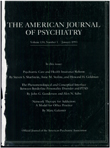Familial association between attention deficit disorder and anxiety disorders
Abstract
BACKGROUND AND METHOD: This study tested hypotheses about patterns of familial association between attention deficit disorder (ADD) and anxiety disorders among 356 first-degree relatives of 73 clinically referred children with ADD and 26 normal comparison children. Through structured diagnostic interviews with trained raters, relatives were assessed for adult and childhood psychopathology. After stratifying the sample of ADD probands into those with anxiety disorders and those without, the authors examined patterns of aggregation of ADD and anxiety disorders in the relatives of these probands as well as in the relatives of the normal comparison subjects. RESULTS: Familial risk analyses revealed that 1) familial risk for anxiety disorders was higher among all ADD probands than among the normal subjects; 2) familial risk for ADD was similar in the relatives of the ADD probands and of the probands with ADD and anxiety disorder; 3) the relatives of the ADD probands with and without anxiety disorders were at greater risk for ADD than the relatives of the normal subjects; 4) the risk for anxiety disorders was two times higher in the relatives of the probands who had ADD with anxiety disorder than in those of the ADD probands without anxiety disorders; and 5) there was a tendency for ADD probands' relatives who themselves had ADD to have a higher risk for anxiety disorders than ADD probands' relatives who did not have ADD (cosegregation). CONCLUSIONS: The results were most consistent with the hypotheses indicating that ADD and anxiety disorders segregate independently in families.
Access content
To read the fulltext, please use one of the options below to sign in or purchase access.- Personal login
- Institutional Login
- Sign in via OpenAthens
- Register for access
-
Please login/register if you wish to pair your device and check access availability.
Not a subscriber?
PsychiatryOnline subscription options offer access to the DSM-5 library, books, journals, CME, and patient resources. This all-in-one virtual library provides psychiatrists and mental health professionals with key resources for diagnosis, treatment, research, and professional development.
Need more help? PsychiatryOnline Customer Service may be reached by emailing [email protected] or by calling 800-368-5777 (in the U.S.) or 703-907-7322 (outside the U.S.).



